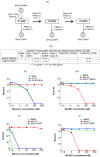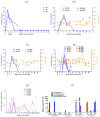Infection of Chinese Rhesus Monkeys with a Subtype C SHIV Resulted in Attenuated In Vivo Viral Replication Despite Successful Animal-to-Animal Serial Passages
- PMID: 33801437
- PMCID: PMC7998229
- DOI: 10.3390/v13030397
Infection of Chinese Rhesus Monkeys with a Subtype C SHIV Resulted in Attenuated In Vivo Viral Replication Despite Successful Animal-to-Animal Serial Passages
Abstract
Rhesus macaques can be readily infected with chimeric simian-human immunodeficiency viruses (SHIV) as a suitable virus challenge system for testing the efficacy of HIV vaccines. Three Chinese-origin rhesus macaques (ChRM) were inoculated intravenously (IV) with SHIVC109P4 in a rapid serial in vivo passage. SHIV recovered from the peripheral blood of the final ChRM was used to generate a ChRM-adapted virus challenge stock. This stock was titrated for the intrarectal route (IR) in 8 ChRMs using undiluted, 1:10 or 1:100 dilutions, to determine a suitable dose for use in future vaccine efficacy testing via repeated low-dose IR challenges. All 11 ChRMs were successfully infected, reaching similar median peak viraemias at 1-2 weeks post inoculation but undetectable levels by 8 weeks post inoculation. T-cell responses were detected in all animals and Tier 1 neutralizing antibodies (Nab) developed in 10 of 11 infected ChRMs. All ChRMs remained healthy and maintained normal CD4+ T cell counts. Sequence analyses showed >98% amino acid identity between the original inoculum and virus recovered at peak viraemia indicating only minimal changes in the env gene. Thus, while replication is limited over time, our adapted SHIV can be used to test for protection of virus acquisition in ChRMs.
Keywords: Chinese rhesus macaques; SHIV; subtype C.
Conflict of interest statement
The authors declare no conflict of interest. The funders had no role in the design of the study; in the collection, analyses, or interpretation of data; in the writing of the manuscript, or in the decision to publish the results.
Figures





Similar articles
-
Enhanced infectivity of an R5-tropic simian/human immunodeficiency virus carrying human immunodeficiency virus type 1 subtype C envelope after serial passages in pig-tailed macaques (Macaca nemestrina).J Virol. 2000 Jul;74(14):6501-10. doi: 10.1128/jvi.74.14.6501-6510.2000. J Virol. 2000. PMID: 10864663 Free PMC article.
-
Novel Strategy To Adapt Simian-Human Immunodeficiency Virus E1 Carrying env from an RV144 Volunteer to Rhesus Macaques: Coreceptor Switch and Final Recovery of a Pathogenic Virus with Exclusive R5 Tropism.J Virol. 2018 Jun 29;92(14):e02222-17. doi: 10.1128/JVI.02222-17. Print 2018 Jul 15. J Virol. 2018. PMID: 29743361 Free PMC article.
-
Immunization of macaques with live simian human immunodeficiency virus (SHIV) vaccines conferred protection against AIDS induced by homologous and heterologous SHIVs and simian immunodeficiency virus.Virology. 2002 Sep 30;301(2):189-205. doi: 10.1006/viro.2002.1544. Virology. 2002. PMID: 12359422
-
Protective effects of nef-deleted SHIV or that having IFN-gamma against disease induced with a pathogenic virus early after vaccination.Arch Virol. 2004 Sep;149(9):1705-20. doi: 10.1007/s00705-004-0333-8. Arch Virol. 2004. PMID: 15593414
-
Vaccine-based, long-term, stable control of simian/human immunodeficiency virus 89.6PD replication in rhesus macaques.J Gen Virol. 2007 Feb;88(Pt 2):652-659. doi: 10.1099/vir.0.82469-0. J Gen Virol. 2007. PMID: 17251584
Cited by
-
Heterologous Immunization with Improved HIV-1 Subtype C Vaccines Elicit Autologous Tier 2 Neutralizing Antibodies with Rapid Viral Replication Control After SHIV Challenge.Viruses. 2025 Feb 17;17(2):277. doi: 10.3390/v17020277. Viruses. 2025. PMID: 40007032 Free PMC article.
-
Assessment of an LSDV-Vectored Vaccine for Heterologous Prime-Boost Immunizations against HIV.Vaccines (Basel). 2021 Nov 5;9(11):1281. doi: 10.3390/vaccines9111281. Vaccines (Basel). 2021. PMID: 34835214 Free PMC article.
References
-
- Nishimura Y., Igarashi T., Donau O.K., Buckler-White A., Buckler C., Lafont B.A., Goeken R.M., Goldstein S., Hirsch V.M., Martin M.A. Highly pathogenic SHIVs and SIVs target different CD4+ T cell subsets in rhesus monkeys, explaining their divergent clinical courses. Proc. Natl. Acad. Sci. USA. 2004;101:12324–12329. doi: 10.1073/pnas.0404620101. - DOI - PMC - PubMed
Publication types
MeSH terms
Substances
LinkOut - more resources
Full Text Sources
Other Literature Sources
Research Materials

